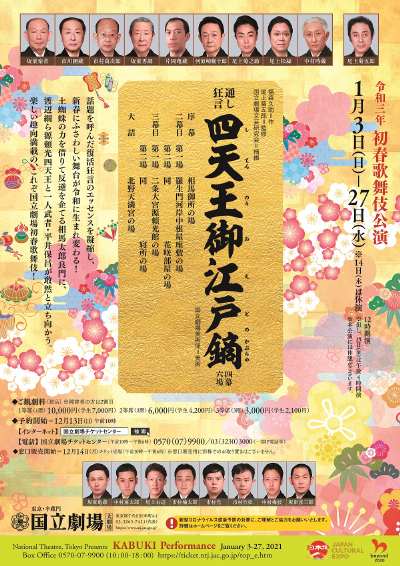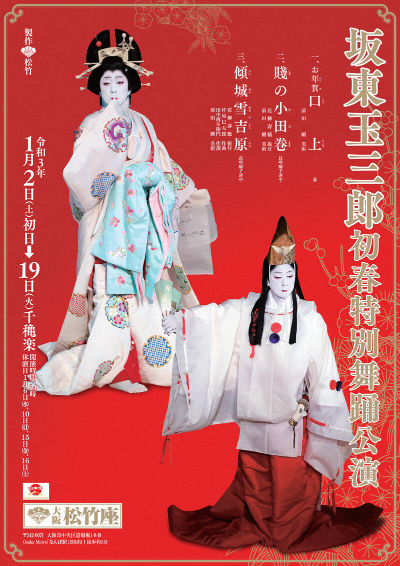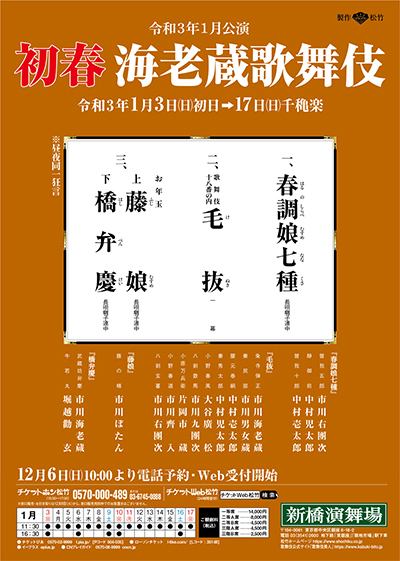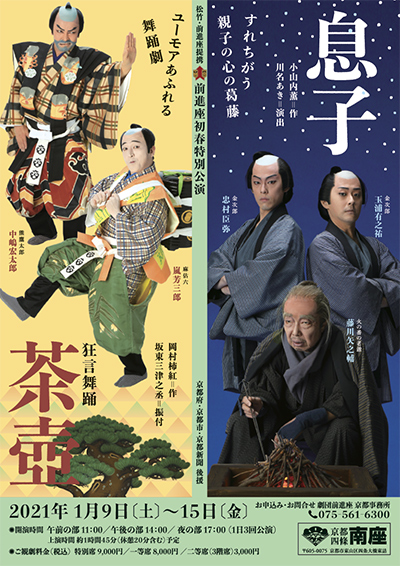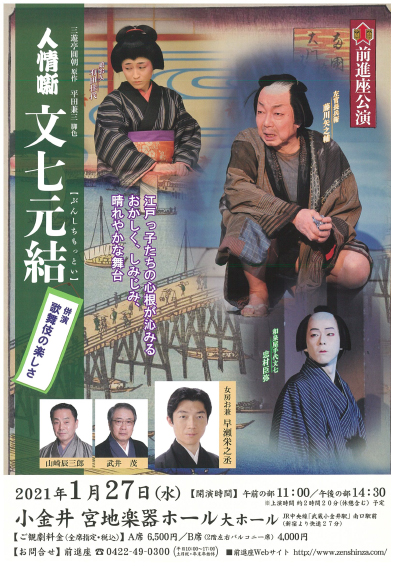| Dates |
3 ~ 27 January 2021 |
| Program |
Shitenn˘ Oedo no Kaburaya
|
| Casting |
Onoe Kikugor˘, Nakamura Tokiz˘, Onoe Kikunosuke, Onoe Sh˘roku, Ichikawa Danz˘, Band˘ Rakuzen, Kataoka Kamez˘, Band˘ Hikosabur˘,
Band˘ Kamez˘, Nakamura Baishi, Onoe Ukon, Band˘ Shűch˘, Kawarasaki Gonjűr˘, Ichimura Manjir˘, Nakamura Mantar˘, Ichimura Takematsu, Ichimura Hikaru, Ichimura Kitsutar˘
|
| Comments |
Revival at the National Theatre of Fukumori Kyűsuke I's long-forgotten kaomise drama "Shitenn˘ Oedo no Kaburaya",
which was premiered in the 11th lunar month of 1815 in Edo at the Nakamuraza and was revived in January 2011 at the National Theatre [more details].
Shitenn˘ Oedo no Kaburaya: in January 2011, "Shitenn˘ Oedo no Kaburaya" was presented for the first
time in about 200 years at the National Theatre, and was met with great acclaim.
Set in the middle of the Heian period, it depicts the heroic actions
of four loyal retainers of the warlord Minamoto no Yorimitsu (Nakamura Baishi),
including Watanabe no Tsuna (Living National Treasure Onoe Kikugor˘), and the ambitions of the late
Taira no Masakado's son Yoshikado, who aims to rule the country.
In homage to original actor Onoe Kikugor˘ III, the piece features one of the
specialty plays of the Onoe family: "Tsuchi-gumo" (The Earth Spider).
Centered on the tales of how the Minamoto clan subjugated the Emperor's enemies and vanquished a giant
ôearth spider,ö this has evolved into a highly entertaining piece; today's performance captures the essence
of the original. S˘ma no Tar˘ Yoshikado (Onoe Sh˘roku), who follows the wishes of his late father Taira no Masakado,
aims to come into power and retaliate against the Minamoto clan through the use of the sorcery of the
earth spider, which lives on Mount Katsuragi. Carrying with them the
Naishidokoro no Mikagami (mirror that forms part of the sacred imperial regalia), which Yoshikado
had stolen, and the S˘ma family heirloom Tsunagi Uma no Hata (sacred banner with an image of a tethered horse),
the factions of Yorimitsu headed by Watanabe no Tsuna
and Yoshikado's group ľ along with the earth spider (Onoe Kikunosuke) ľ face off in a battle of wits. The opening scene compares
Yoshikado's rise and revolt to the feast at the Palace of the Dragon King; the strange relationship between
Tsuna in the disguise of tobigashira (a head fireman),
the beautiful, mysterious prostitute Hanazaki (Onoe Kikunosuke) and her mother Ibarakibaba (Nakamura Tokiz˘); an unexpected connection between
Hakamadare Yasusuke, a hell-raising thief in Edo, and the fierce warrior Hirai no Yasumasa (Onoe Sh˘roku).
In a harsh battle in which a member of four loyal retainers possessing the Suiha no Kaburaya (magical arrow)
throws down the gauntlet to the earth spider amid bright red flames - all of these unimaginable developments
unfold through brilliant staging effects, and many entertaining moments, that can only be seen in the
National Theatre's New Year Kabuki Performance.
Source: National Theatre website
|
| Dates |
2 ~ 27 January 2021
Kotobuki Hatsuharu ďkabuki
Congratulation Early Spring Grand Kabuki |
| 1st Program |
Kotohogite Hanagata Tsudou Hashiradate
Akutar˘
|
| 2nd Program |
Yűgiri Nagori no Sh˘gatsu
Kanadehon Chűshingura
(Gion Ichiriki Jaya)
|
| 3rd Program |
Sugawara Denju Tenarai Kagami (Kurumabiki)
Nemuru-ga-Rakuda Monogatari (Rakuda)
|
| Casting |
Living National Treasure Nakamura Kichiemon, Matsumoto Haku˘, Nakamura Baigyoku, Nakamura Shikan, Nakamura Jakuemon, Nakamura Ganjir˘, Nakamura Senjaku, Kataoka Ainosuke, Matsumoto K˘shir˘, Ichikawa Ennosuke, Ichikawa Sadanji, Band˘ Yajűr˘, Nakamura Matagor˘,
Onoe Matsuya, Nakamura Hayato, Band˘ Minosuke, Band˘ Shingo, Kamimura Kichiya, Ichikawa En'ya, Nakamura Matsue, Matsumoto Kingo, Nakamura Kikaku, Nakamura Kash˘, Nakamura Yonekichi, Nakamura Kangyoku, Nakamura Takanosuke, ďtani Hirotar˘, Nakamura Tsurumatsu, Nakamura Tanenosuke, Ichikawa Somegor˘,
Nakamura Jűjir˘, Arashi Kitsusabur˘, Nakamura Kichinoj˘, Nakamura Baika, Nakamura Fukunosuke, Nakamura Utanosuke, Nakamura Toranosuke, Nakamura Tamatar˘, Ichikawa Otora
|
| Comments |
The three programs for the New Year Grand Kabuki at the Kabukiza.
Kotohogite Hanagata Tsudou Hashiradate:
(Auspicious Ceremony of Building the First Pillar enacted by Young Stars)
Kud˘ Suketsune (Nakamura Kash˘) was appointed Marshal of the Hunt at the foot of Mt. Fuji
by his master Minamoto no Yoritomo. For this occasion,
he intends to build a temporary hunting lodge and holds a ceremony dedicated to the foundation of its first pillar.
The Soga brothers Jűr˘ (Nakamura Hayato) and Gor˘ (Onoe Matsuya) who seek Suketsune's life as their father's slayer
also attend this ceremony. While Maizuru (Band˘ Shingo), the cha b˘zu Chinsai (Nakamura Tanenosuke) and Kisegawa (Nakamura Tsurumatsu) appease the furious Gor˘, Suketsune tells how their father Kawazu Sabur˘ Sukeyasu was killed.
Akutar˘: this dance is based on a comic Ky˘gen play and
was written for Ichikawa En'˘ and was one of his specialities. This dance shows a wild drunkard named Akutar˘ (Ichikawa Ennosuke).
He appears with a bushy beard and long halberd and waves it around wildly. But his uncle (Ichikawa En'ya) has a plan to cure him
of drinking.
Yűgiri Nagori no Sh˘gatsu: the roots of this play go back to the earliest days of Kabuki.
The young lover Fujiya Izaemon (Nakamura Ganjir˘) has been disowned by his family for loving a courtesan.
This role is a classic example of wagoto, the gentle style of
acting that was popular in the Kansai region.
His lover ďgiya Yűgiri (Nakamura Senjaku), the fabulous courtesan, died pining away with love for him. As he prays to Amida Buddha
to hold a memorial service for her, he faints and she appears. They celebrate their reunion and reminisce
about the past, but she disappears. He is pleased with seeing her though in dream.
This particular version of the play was originally written by Chikamatsu Monzaemon.
But since the original script had long been lost, this version of the story was written in 2005.
Nakamura Ganjir˘ will also wear a real paper kimono, the trademark of Sakata T˘jűr˘ I.
Gion Ichiriki Jaya: "Chűshingura" is one of
the most popular plays in the theatre and shows a true event when forty-seven
masterless samurai avenged the death of their lord by killing his enemy.
The seventh act is one of the most popular and shows the leader of the vendetta
Yuranosuke as he is hiding his intention to avenge his lordĺs death by pretending
to be only interested in pleasure, but also encountering key figures on
his side and the side of the enemy. Yuranosuke (Living National Treasure Nakamura Kichiemon)
spends his days and nights in the pleasure quarters of Ky˘to in an effort to
make their lordĺs enemy, Moron˘, believe he is not planning a vendetta.
His acting is so good that even men in his own group believe he has given his
life up to pleasure. Moron˘ is not so easily convinced, though, and has sent spies,
including a former retainer of their late lord, En'ya Hangan, to find Yuranosuke's
true intentions. Okaru (Nakamura Jakuemon), the wife of one of the retainers is now a
courtesan at the Ichiriki Teahouse, unaware that her husband is dead.
Okaru's brother Heiemon (Nakamura Baigyoku), a servant in the Hangan household,
has also come to the teahouse and the interaction of these characters
becomes a matter of life and death and ends with Yuranosuke preparing to
lead the vendetta.
Kurumabiki: this short scene shows the three brothers that dominate
the drama "Sugawara Denju Tenarai Kagami",
each with a distinctive personality. Sakuramaru (Ichikawa Somegor˘) and
Ume˘maru (Matsumoto K˘shir˘) have been rendered
masterless by Kan Sh˘j˘'s exile. The third brother Matsu˘maru (Matsumoto Haku˘) serves
the villain Shihei (Band˘ Yajűr˘), who is responsible for the downfall of Kan Sh˘j˘.
Sakuramaru and Ume˘maru try to destroy Shihei's carriage but are stopped by Matsu˘maru
and the magical glare of Shihei. Finally the brothers agree to suspend their disputes
until they all meet at their father's seventieth birthday party.
Rakuda: this is a popular dramatization of a rakugo comic
story. A petty gang boss named Rakuda (Nakamura Matsue) has died after eating blowfish.
Hanji (Nakamura Shikan), one of his gang members, finds him and hopes to bury him,
but has no money. When he tries to get the neighbors to contribute,
everyone is overjoyed that such a nuisance is dead, but won't contribute a
cent towards his burial. Finally Hanji pulls in a passing waste paper collector
named Kyűroku (Kataoka Ainosuke) and forces him to carry around Rakuda's body and
threaten to make it dance if the neighbors won't pay up.
They get a great sum of money and start drinking together.
But as he drinks, the hapless Kyűroku becomes surprisingly aggressive.
Sources: Earphone Guide Website or Sh˘chiku Kabuki Official Website
|
| Dates |
2 ~ 19 January 2021
Hatsuharu Tokubetsu Buy˘ K˘en
Band˘ Tamasabur˘ Hatsuharu Tokubetsu Buy˘ K˘en
Band˘ Tamasabur˘ Early Spring Special Dance Performances |
| Program |
K˘j˘
Shizu no Odamaki
Keisei Yuki no Yoshiwara
|
| Casting |
Living National Treasure Band˘ Tamasabur˘
|
| Comments |
A special Buy˘ program at the Sh˘chikuza starring Living National Treasure Band˘ Tamasabur˘.
K˘j˘: the close relationship between the actors and the audience
is shown by stage announcements, usually lavish ceremonies to commemorate various
important events. This month at the Sh˘chikuza, it is a stage speech delivered by Living National Treasure Band˘ Tamasabur˘ in celebration of the beginning of the New Year.
Shizu no Odamaki: after sadly parting from her lover Yoshitsune on
Mt. Yoshino and being sent to Kamakura, Shizuka Gozen was captured
by the retainers of Yoshitsune's brother Yoritomo. At the demand of Yoritomo
and his wife Masako, she performed the dance of a shiraby˘shi
(a dancer courtesan) at Tsurugaoka Hachiman Shrine.
While dancing, she expressed her love for Yoshitsune and, instead of praising Yoritomo,
she danced to pray for Yoshitsune's safety. Starring Living National Treasure Band˘ Tamasabur˘ in the role of Shizuka Gozen.
Keisei Yuki no Yoshiwara: This is a brand-new dance, the highlight of which is when the beautiful courtesan in her
gorgeous costume expresses her love for her beloved, romance in the pleasure quarters, and her poor life story
in dance, weaving into that scenes of the four seasons. Starring Living National Treasure Band˘ Tamasabur˘.
Sources: Earphone Guide Website or Sh˘chiku Kabuki Official Website
|
| Dates |
3 ~ 17 January 2021
Hatsuharu Ebiz˘ K˘en
Early Spring Ebiz˘ Performances |
| Program |
Haru no Shirabe Musume Nanakusa
Kenuki
Fuji Musume
Hashi Benkei
|
| Casting |
Ichikawa Ebiz˘, Ichikawa Udanji, Nakamura Kazutar˘, Nakamura Kotar˘, Kataoka Ichiz˘, Ichikawa Sai'nyű, Ichikawa Omez˘, Ichikawa Kudanji, ďtani Hiromatsu, Horikoshi Kangen, Ichikawa Botan
|
| Comments |
The traditional New Year Kabuki at the Shinbashi Enbuj˘
with a troupe led by the young star Ichikawa Ebiz˘.
Musume Nanakusa: in the Edo period, every New Year,
plays appeared about the medieval vendetta carried out by the Soga brothers
Jűr˘ and Gor˘. This colorful, old-fashioned dance mixes this tradition with
that of eating porridge containing seven auspicious herbs on the seventh
day of the new year. As the brothers Jűr˘ (Nakamura Kazutar˘) and Gor˘ (Ichikawa Udanji)
prepare to face their father's murderer and take revenge, along with beautiful
Shizuka Gozen (Nakamura Kotar˘), they cut the herbs, as a symbolic act of vengeance.
Kenuki: in this play, which retains the light, festive atmosphere of
early-period Kabuki, a princess has a mysterious ailment that makes her hair stand
on end, an ailment that prevents her from carrying out her long-awaited marriage.
Kumedera Danj˘ comes from the groom's household to investigate and finds a plot
to take over the household when his tweezers float in mid-air.
Ichikawa Ebiz˘ stars in a play that features the bombastic aragoto
style of acting that is a specialty of his family. Featuring also Ichikawa Udanji, Nakamura Kazutar˘, Nakamura Kotar˘, Ichi5 and Ichikawa Sai'nyű.
Fuji Musume: the spirit of wisteria blossoms dances of love in the form of a
beautiful young maiden. One of Kabuki's most famous and colorful dances, it will
feature the dancing skills of Ichikawa Ebiz˘'s daughter Ichikawa Botan.
Hashi Benkei:
(Benkei on the Bridge)
There are many legends
about Benkei, the warrior-priest who was the
faithful companion of the general Yoshitsune. This dance shows the first
meeting of Benkei and Yoshitsune. Benkei goes nightly to the bridge at the
Fifth Avenue of Ky˘to, defeating men night after night and taking their swords.
Finally he encounters a delicate young man that he thinks will be an easy opponent,
but is defeated himself instead. This young man was Yoshitsune, under
his childhood name of Ushiwakamaru. Benkei is so impressed that he becomes Yoshitsuneĺs retainer, right there and then.
Starring Ichikawa Ebiz˘ as Benkei and Ichikawa Ebiz˘'s son Horikoshi Kangen as Ushiwakamaru.
Sources: Earphone Guide Website or Sh˘chiku Kabuki Official Website
|
| Minamiza (Ky˘to) |
 |
|
| Dates |
9 ~ 15 January 2021
Zenshinza Hatsuharu Tokubetsu K˘en
Zenshinza Early Spring Special Performances |
| Program |
Musuko
Chatsubo
|
| Casting |
Fujikawa Yanosuke, Arashi Yoshisabur˘, Tadamura Shin'ya, Tamaura Yűnosuke, Hayase Einoj˘, Nakajima K˘tar˘, Motomura Yűki, Niimura S˘jir˘, Fujii Isaku
|
| Comments |
The traditional Zenshinza New Year performances in Ky˘to at the Minamiza.
Musuko: A modern play that shows a thief on the run who takes refuge in the shack of the guardman
of a fire watchhouse. The thief is the same age as the old man's son and gradually he realizes that this
is his father. But he conceals his identity because the old man is fondly convinced that his son has become
a success somewhere. Starring Fujikawa Yanosuke as the old man.
Chatsubo: the farces of the classical Ky˘gen
theater have universal appeal, showing the relationships of masters and servants and
husbands and wives. In this particular dance play, a servant (Arashi Yoshisabur˘) carries a precious
tea caddy which a thief then claims is his. The servant and the thief must both explain who owns the treasure,
first in words, then in dance.
Sources: Earphone Guide Website or Sh˘chiku Kabuki Official Website
|

